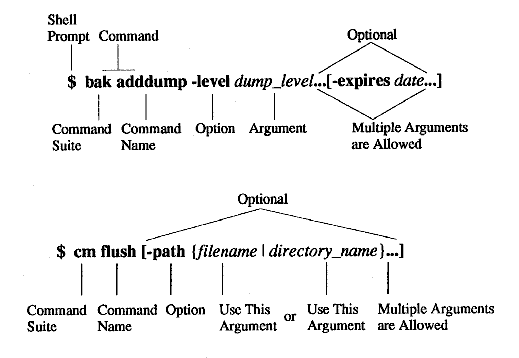
All DFS commands share a common structure. The following example shows the basic format of a DFS command:
$ command {-option1 argument... | -option2 {argument1 | argument2}...} \
[-optional_information]
The following examples illustrate the elements of a DFS command:
Examples

The following list summarizes the elements of a DFS command:
Command
A command consists of the command suite (bak and cm in the preceding examples) and the command name (adddump and flush in the examples). The
command suite and the command name must always be typed together, separated by a space. The command suite specifies the group of related commands to which the command belongs; the command name
directs the server process or program to perform a specific action. Both the command suite and the command name always appear in bold font in the text.
Options
Command options always appear in bold font in the text, are always preceded by a - (dash), and are often followed by arguments. In the first example, -level
and -expires are options, and dump_level and date are their arguments; in the second example, -path is the only option.
An option and its arguments tell the server process or program which entities to manipulate when executing the command (for example, the dump level to affect and the date to assign to that level). In general, you should provide the options for a command in the order presented in the documentation.
Arguments
Arguments for options always appear in italic font in the text. The { | } (braces separated by a vertical bar) indicate that you can enter only one of two possible
arguments (or use only one of two possible options). In the second example, you can enter either a filename or a directory_name; the ... (ellipsis) following the closing brace
indicates that multiple filenames, directory_names, or both can be entered.
Optional Information
Some commands have optional, as well as required, options. Optional information is enclosed in [ ] (brackets). The -expires option and its
date argument in the first example are optional, as are the -path option and its filename and directory_name arguments in the second example. Options and their
arguments are optional only if they are enclosed in [ ] (brackets).
Enter each DFS command and its options and arguments on a single line followed by a carriage return at the end of the line. Use a space to separate each element (command suite, command name, options, and arguments) on a command line. Also use spaces to separate multiple arguments. Do not use a space to separate an option from its - (dash).
More: